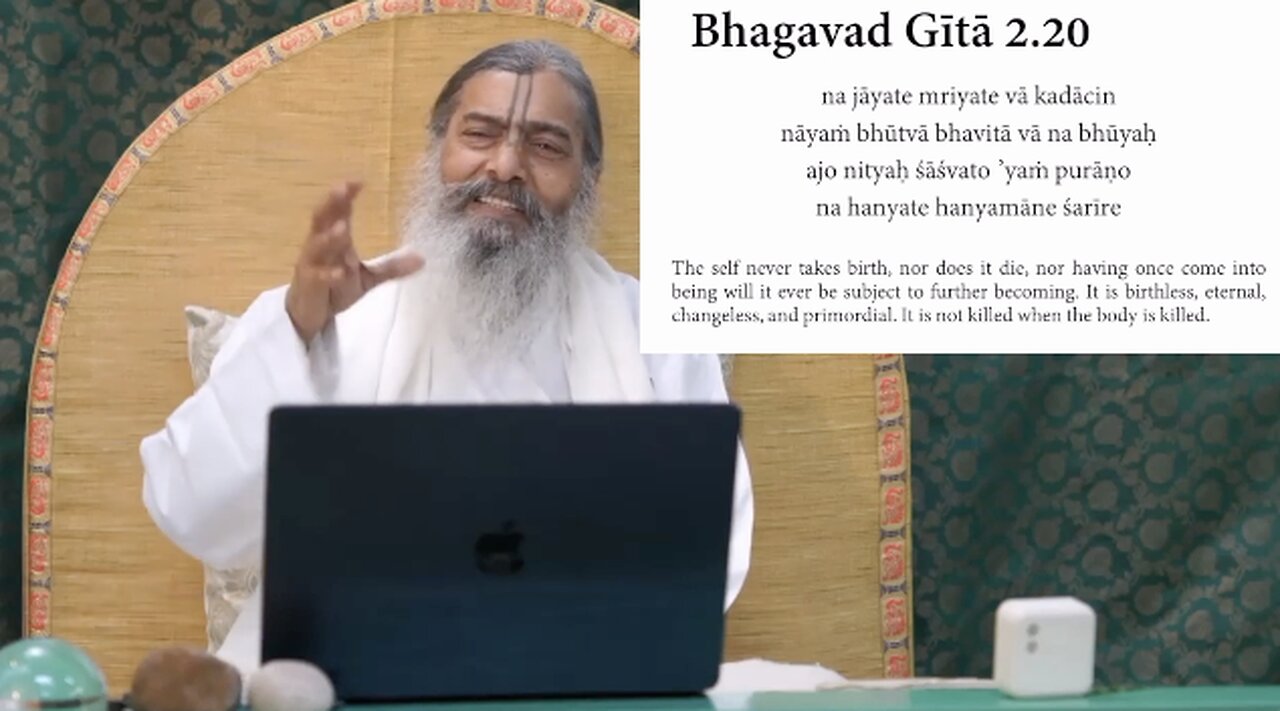Premium Only Content

Adding The Conscious Self (Ātma) To The Hard Problem of Consciousness
More videos like this on my you tube channel
https://www.youtube.com/@dayanidhi9391
```````````````````````````````````````````
What is called the ātma (Self) in Vedānta, is called the puruṣa (the principle of consciousness) in the ancient philosophy of Saṃkhyā. In Patañjali's Yoga Sūtras it is called the draṣṭṛ (the seer) and in Chapter 13 of the Bhagavad-Gītā it is called the kshetra-jña (the knower of the field). So ātma, puruṣa, draṣṭṛ, kshetra-jña, these are all synonyms for the eternal, unchanging Self. In other religious traditions and philosophies it is called the spirit or the soul.
Because the intrinsic nature of the ātma is that it is conscious (chit), it is therefore aware of all vṛttis in the mind. The Sanskrit word vṛtti (वृत्ति) refers to any cognitive act performed by the mind and intellect. So all our thoughts, all our perceptions (of sight, hearing, smell, taste and touch), all our emotions, all our feelings, all our ideas, etc, they are all vṛttis. In short, any state of mind whatsoever is a vṛtti. Vṛttis are also explained in this video.
Now, when someone says "I see a tree" or "I smell a rose", or "I feel sad" or "I feel happy", what, actually, is this 'I' that is being referred to?
Generally, when not really scrutinising the matter, most people will take this 'I' to be the body/mind, but if we accept that both the tree and the scent of the rose, as well as feelings like sadness and happiness, are all actually vṛttis appearing in the mind, and that ultimately the experiencer of these vṛttis is this conscious ātma, then it is actually this ātma that is the 'I' that's being referred to in such statements as "I see", "I smell", "I feel", etc. It is this ātma, which is distinct from the body and mind, that is true Self or true 'I'.
The body and mind, which are made of gross and subtle material elements respectively, are really just external instruments that the ātma 'uses' for the time that it is embodied. The body and mind may be compared to a kind of space suit that the ātma 'wears' for the time that it has to interact with this temporary, earthly dimension. And while the body and mind might appear to be conscious, because they are both material (unlike the ātma which is purely spiritual) they do not have consciousness as their intrinsic nature. They only appear to be conscious on account of the consciousness of the ātma pervading and animating them both.
The physical body is left behind at the time of death, and it then dissolves back into the gross material elements from which it was made. But the mind, which is an aspect of what is called sukshma-sharira or subtle body, continues to exist after the death of the body. When moksha (liberation) from the cycle of birth and death is attained, the mind is also left behind, and it dissolves back into the subtle material elements.
-
 1:42:33
1:42:33
The Criminal Connection Podcast
18 hours ago $3.27 earnedNICK MORAN Lock Stock SECRETS, Punching Paparazzi & Living with Jason Statham (Honest SNATCH Review)
15.8K2 -
 12:38
12:38
The Gun Collective
15 hours agoWOW! New Guns that JUST came out!
16.2K2 -
 59:21
59:21
Trumpet Daily
19 hours ago $7.11 earnedJCPOA 2.0 - Trumpet Daily | Apr. 15, 2025
21.4K9 -
 24:56
24:56
The Brett Cooper Show
1 day ago $8.73 earnedWhat Hollywood Can Learn From the Minecraft Movie | Episode 22
39.1K51 -
 18:23
18:23
Michael Franzese
16 hours agoTom Hardy Is Back — And He’s Absolutely Ruthless | Mobland Review
65.7K8 -
 3:03:30
3:03:30
TimcastIRL
10 hours agoDemocrats Prep Trip To El Salvador To SAVE MS-13 Gang Member, Bring Terrorist To US | Timcast IRL
252K199 -
 2:30:28
2:30:28
Laura Loomer
12 hours agoEP114: Trump Cracks Down On Animal Testing
121K47 -
 2:08:29
2:08:29
RiftTV/Slightly Offensive
12 hours ago $27.41 earnedTexas MURDERER Karmelo Anthony Gets $800K House with GOFUNDME MONEY? | Slightly Offensive
84.1K55 -
 1:13:18
1:13:18
Glenn Greenwald
13 hours agoTrump Meets with El Salvador's Bukele: A Tyrant or a Model to Copy? Plus: Trump's Proposal to Deport Citizens There | SYSTEM UPDATE #439
148K195 -
 14:00:04
14:00:04
MDGgamin
19 hours ago🔴LIVE -TARKOV & Path Of Exile 2- Live Long Enough To Become The Villain. - #RumbleTakeover
42.4K1